|
|
|
Sort Order |
|
|
|
Items / Page
|
|
|
|
|
|
|
| Srl | Item |
| 1 |
ID:
159150
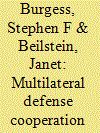

|
|
|
|
|
| Summary/Abstract |
Some U.S. military leaders have asserted that the United States, Japan, Australia, and India and the Republic of Korea are developing multilateral defense cooperation to deter aggression and uphold norms much like North Atlantic Treaty Organization (NATO) has in Europe. Frequent military exercises and China’s threats to freedom of navigation (FoN) and North Korea’s nuclear missiles comprise the motive force for such cooperation. However, cooperation thus far has been trilateral and minimal, given divergent national interests and dispersed geopolitical locations. Cooperation among Japan, Republic of Korea (ROK), and the United States is increasing given the threat, but ROK’s public opinion is divided about Japan. Australia, Japan, and India have increased cooperation with the United States but are reluctant to conduct FoN operations with the United States to challenge China’s expansionism in the South China Sea. If China becomes more aggressive and blocks FoN or seizes territory, development toward an Asian NATO is possible.
|
|
|
|
|
|
|
|
|
|
|
|
|
|
|
|
| 2 |
ID:
159151
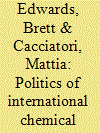

|
|
|
|
|
| Summary/Abstract |
There has been near-universal condemnation of the use of chemical weapons in the Syrian conflict. The international community has nevertheless struggled to make progress on holding the perpetrators to account. This article reviews developments at the international level in terms of Syrian chemical weapon justice between 2011 and 2017. It argues that there have been substantive disagreements between states on the rationale and means of justice in the Syrian case. It also argues that international initiatives have been tightly intertwined with developments in chemical disarmament and conflict resolution processes as well as the broader war. The article describes progress and challenges to chemical weapon justice in a number of distinct formal international mechanisms during the period studied. The analysis concludes by contextualizing international responses—including the U.S. tomahawk strikes against a Syrian airbase—to the Khan Shaykhun chemical attacks of April 2017.
|
|
|
|
|
|
|
|
|
|
|
|
|
|
|
|
| 3 |
ID:
159149
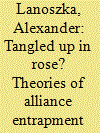

|
|
|
|
|
| Summary/Abstract |
Recent tensions between Russia and the United States have sparked debate over the value of the North Atlantic Treaty Organization (NATO). One controversy surrounds the extent to which NATO raises the risk of war through entrapment—a concept that scholars invoke to describe how states might drag their allies into undesirable military conflicts. Yet scholars have advanced different, even conflicting arguments about how entrapment risks arise. I offer a typology that distinguishes between the mechanisms through which entrapment risks allegedly emerge on the basis of their institutional, systemic, reputational, and transnational ideological sources. I use the 2008 Russo-Georgian War to illustrate how the purported mechanisms of entrapment fare in elucidating that conflict. In analyzing why entrapment risks emerge, and thinking counterfactually about The 2008 War, I argue that scholars need to disentangle the various mechanisms that drive both alliance formation and war to make sure that entrapment risks do indeed exist.
|
|
|
|
|
|
|
|
|
|
|
|
|
|
|
|
| 4 |
ID:
159152


|
|
|
|
|
| Summary/Abstract |
Private military and security companies (PMSCs) play an increasingly important role in the provision of security-related services. In their attempts to win new clients and find suitable personnel, they take on different identities by presenting themselves as conventional businesses, military actors, and humanitarians. In this article, we examine how PMSCs deploy these identities when they recruit new personnel through social media. Our computer-assisted content analysis of Twitter messages posted by two major United States-based companies—CACI and DynCorp International—shows that while both PMSCs amplify their business and military identities to attract the most talented personnel, they construct and communicate these identities in different ways with CACI branding itself as a sophisticated, modern, and patriotic business and DynCorp as a home-grown, traditional military provider. In addition, our analysis lends force to scholars suggesting that state militaries and the private security sector compete increasingly for prospective employees using similar strategies.
|
|
|
|
|
|
|
|
|
|
|
|
|
|
|
|
| 5 |
ID:
159147
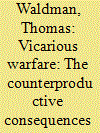

|
|
|
|
|
| Summary/Abstract |
This article examines contemporary modes of American warfare. It posits the concept of “vicarious warfare” as a means of capturing prominent patterns in warfighting approaches. Although rooted in long-standing traditions of military practice, vicarious warfare is sufficiently novel as to be identifiable as a distinct phenomenon. The precise manifestation or combination of vicarious methods vary according to the specific circumstances and political contexts prevailing in different theaters. However, America’s general preference is to fight its wars by delegating tasks to proxies and limiting exposure of its own military to danger. Where U.S. forces are employed directly, this takes place largely in the shadows. Such approaches have clear attractions, offer undoubted tactical advantages, and permit successive administrations to maintain a persistent tempo of operations that evades rigorous democratic scrutiny. Yet, prominent cases and numerous studies suggest that vicarious warfare has a high potential to generate counterproductive effects and significant strategic harm.
|
|
|
|
|
|
|
|
|
|
|
|
|
|
|
|
| 6 |
ID:
159148
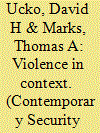

|
|
|
|
|
| Summary/Abstract |
The malaise that the United States, and the West, have experienced in recent campaigns stems in large part from unclear thinking about war, its political essence, and the strategies needed to join the two. Instead, analysis and response are predicated on entrenched theoretical concepts with limited practical utility. The inadequacy of understanding has spawned new, and not so new, terms to capture unanticipated trends, starting with the re-discovery of “insurgency” and “counterinsurgency” and leading to discussion of “hybrid threats” and “gray-zone” operations. New terminology can help, but the change must go deeper. Challenging analytical orthodoxy, this article sets out a unifying approach for the study of political violence, or more accurately: violent politics. It provides a conceptual foundation that helps to make sense of recent shifts in warfare. In effect, it offers sorely needed theoretical insights into the nature of strategy and guides the process of responding to nontraditional threats.
|
|
|
|
|
|
|
|
|
|
|
|
|
|
|
|
|
|
|
|
|